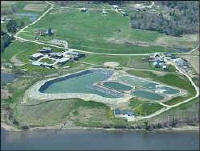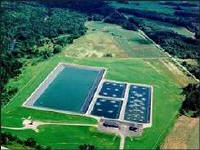|












2003
Maine Wastewater Salary Survey as conducted by the Maine Wastewater Control
Association

2003 Maine
Wastewater Rate Survey conducted by the Maine Rural
Water Association

Maine DEP Monthly
O & M Newsletter
Maine and WEF's
Operation Forum
Penobscot Watershed and Development of a TMDL
EPA Binational Toxics
Strategy
Maine Rural Water
Association
Maine Wastewater
Operator Certification
Guide
Maine Is Technology
Newsletter
Maine
Wastewater Control Association
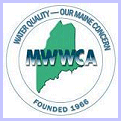
Maine
Wastewater Engineering
Firms
| |
|
|

he Chick Hill Pollution Control Facility, serving the Town of
Rangeley, Maine, was completed in the fall of 1996. The
facility was designed by Wright-Pierce and consists of three new
pump stations, three miles of force main and a new land
application treatment facility at the Chick Hill site. The project
provided the Town with a non-point discharge process designed to
protect the chain of Rangeley Lakes from phosphorous degradation.
The original design of the new facility consisted of
two aerated facultative treatment lagoons constructed in
series with a total capacity of five million gallons. These
treatment lagoons were to be followed by two storage lagoons with
capacities of 28 million gallons and 20 million gallons. The
treated effluent was to be land applied on any combination of nine
spray irrigation fields, each approximately 12 acres.
Due to financial constraints, the scope of the project was
reduced. One of the storage lagoons was removed, limiting total
storage capacity to 28 million gallons, only three of the nine
spray fields were constructed and the control building was reduced
in size. The Town of Rangeley constructed the facility to treat
current wastewater flows as well as projected future growth, but
effluent storage capacity was limited to the current average
flows.
During the first year of operation it became evident that a winter
and spring with above average rainfall would threaten to surpass
the storage capacity of the facility.
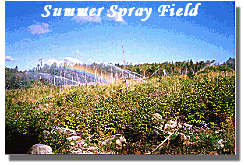
Wright-Pierce provided the
Town with two options. The addition of a second storage lagoon
would provide the facility with enough volume for extraordinarily
wet seasons as well as future increased flows associated with
growth. Furthermore, an additional spray field would assure
adequate future disposal area. The other option involved utilizing
conventional snowmaking technology to generate snow from the
facility's treated effluent. This would enable the Town to reduce
the volume in the storage lagoon during the winter months and
store the frozen effluent on designated land application fields.
The stored effluent would then be applied to the fields as it
melts in the spring and summer.
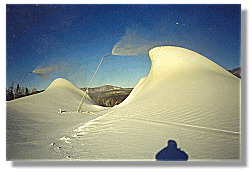
In the spring of 1998 the Town chose to construct the Chick Hill
Winter Effluent Storage and Disposal Facility. The new facility
includes an addition to the existing operations building,
providing space for the snowmaking equipment and maintenance. The
snowmaking room houses a 75 horsepower compressor, a 75 horsepower
vertical turbine pump, an air dryer, air filters and controls to
operate the complete system. The design has also provided room for
additional snowmaking equipment, and additional guns should the
Town expand facilities in the future. Effluent and air piping to
the snow fields is buried steel pipe installed below the frost
line to prevent freezing. At the snow fields there are seven fixed
snow gun locations. At each location a hydrant is connected to the
buried air and water pipes within a four foot diameter concrete
structure. The air / water hydrants control flow to each snow gun,
and flexible hoses connect the hydrants to the guns. Snow
Economics Inc. provided the hydrants and HKD snow guns. HKD
technology has been developed and proven to provide maximum
efficiency, ease of operation and low maintenance. These
specialized guns minimize the air / water ratio, which increases
snowmaking capacity while cutting potentially high compressed air
costs.
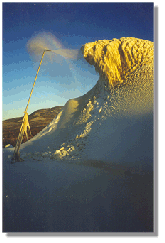
The snowmaking system as constructed can convert approximately 250
gallons per minute of effluent into snow using any combination of
the seven snow guns.
Hydrogeologists from S.W. Cole provided modeling of the snowfields
to determine the capacity of the underlying soils, and the Maine
Department of Environmental Protection (MDEP) agreed to the
application of up to 14-million gallons of effluent annually.
The total project cost was approximately $500,000. Funding for the
project was provided by grants from the MDEP and the United States
Department of Agriculture, Rural Development Office. A loan from
the Maine State Revolving Loan Fund was secured for the Town's
share of the project. |
Snow Making Details

|
The facility utilizes seven snow guns, five of which are in one
field and two in another.
Capacity is maintained for 4 more guns for future expansion. Each
snowmaking field is 20 acres not including the buffer area. The
pump and air compressor used in the process are 75 horsepower. The
snow is pumped at a rate of 310 gallons per minute and the air
rate is 108 psi. The first winter the system sprayed 9.5 mg of
effluent and in 1999-2000 winter sprayed 14.3 million gallon. The
snow is generally melted by mid July. |
Snowmaking Totals
Chick Hill Winter Spray Facility
1999-2000
Month
Year |
Pump
Hours |
Air
Compress Hours |
Days
of Operat. |
Kilowatts Consumed |
Kilowatt
Cost |
Cost
Kilowatt |
Snow
Gallons |
Electrical
Cost
per
Gallon |
Degree
Days |
| |
|
|
|
|
|
|
|
|
|
|
Oct-99 |
0 |
0 |
0 |
0 |
0 |
$0.00 |
- |
0 |
780 |
|
Nov-99 |
54.2 |
39.3 |
8 |
8,960 |
0.186 |
1,166.56 |
308,560 |
0.0054 |
912 |
|
Dec-99 |
330.4 |
141 |
24 |
37,200 |
0.128 |
4,761.60 |
5,717,499 |
0.0008 |
1,344 |
|
Jan-00 |
303.3 |
133.1 |
26 |
21,260 |
0.151 |
3,210.26 |
5,683,902 |
0.0006 |
1,743 |
|
Feb-00 |
82.7 |
43.5 |
12 |
22,180 |
0.167 |
3,704.06 |
1,554,529 |
0.0024 |
1,432 |
|
Mar-00 |
56.1 |
54 |
6 |
2,460 |
0.143 |
351.78 |
1,060,022 |
0.0003 |
|
| |
|
|
76 |
|
|
|
|
|
|
|
Totals |
826.7 |
410.9 |
76 |
92,060 |
|
$13,694.26 |
|
|
|
| |
|
|
|
76 |
|
|
14,324,522 |
|
|
| |
|
|
|
Average |
$0.129 |
|
|
$0.0016 |
|
Snowmaking Totals
Chick Hill Winter Spray Facility
1998-1999
Month
Year |
Pump
Hours |
Air
Compress Hours |
Days
of Operat. |
Kilowatts Consumed |
Kilowatt
Cost |
Electrical
Cost
Kilowatt |
Snow
Gallons |
Electrical
Cost
per
Gallon |
Degree
Days |
|
|
|
|
|
|
|
|
|
|
|
|
Oct-98 |
2.0 |
2 |
3 |
770 |
$0.134 |
$103.18 |
19,500 |
0.0053 |
679 |
|
Nov-98 |
2.6 |
2.6 |
2 |
3,200 |
$0.226 |
$723.20 |
43,820 |
0.0165 |
1,019 |
|
Dec-98 |
104.8 |
94.3 |
15 |
17,120 |
$0.159 |
$2,722.08 |
1,293,975 |
0.0021 |
1,247 |
|
Jan-99 |
230.4 |
166.5 |
27 |
25,560 |
$0.142 |
$3,629.52 |
4,049,198 |
0.0009 |
1,621 |
|
Feb-99 |
219.8 |
168 |
26 |
17,280 |
$0.154 |
$2,661.12 |
3,934,460 |
0.0007 |
1,323 |
|
Mar-99 |
13.1 |
12.1 |
2 |
1,040 |
$0.160 |
$166.40 |
235,135 |
0.0007 |
1,204 |
|
|
|
|
76 |
|
|
|
|
|
|
|
Totals |
572.7 |
446.3 |
75 |
64,970 |
|
$10,005.50 |
|
|
|
| |
|
|
|
76 |
|
|
9,576,088 |
|
|
| |
|
|
|
Average |
$0.163 |
|
|
$0.0044 |
|
Lagoon Specifications

|
Lagoons |
No.1 |
No. 2 |
No. 3 |
|
Volume |
2.5 MG |
2.5 MG |
25 MG |
|
Lagoon Sizes |
325' x 150' |
325' x 150' |
600' x 325' |
|
Lagoon Acreage |
1.2 acres |
1.2 acres |
4.5 acres |
|
Aeration |
Fine Bubble |
Fine Bubble |
None |
|
Number of Aerators |
44 |
16 |
None |
|
Comments:
Total lagoon acreage is 6.7 or 291,852 square feet. Facility
has (2) 15 horsepower blowers. Aeration manufacturer is
Environmental Dynamics, Inc. and aerator model is the Reef I unit.
|
System Information

|
Design Flow |
0.150 MGD |
|
Actual Flow |
0.0954
MGD |
|
Discharge To |
Land
application in summer, snow making in winter |
|
Year Built |
1996 |
|
Design Engineers |
Wright-Pierce |
|
Septage Received |
No, Separate septage disposal site
at treatment facilities |
|
Collector System |
7 miles of gravity sewer, 120
manholes, 4 pump stations |
|
Staff Size |
3 Full
Time |
|
Number of Users |
351
Services |
|
Billing Software |
Northern Data Systems |
|
Comments |
Low to
medium I & I. Much of the collection system constructed in 1970.
Facility has constructed a grit chamber utilizing in-house staff. |
Back to Lagoons in Maine

|
|
|
